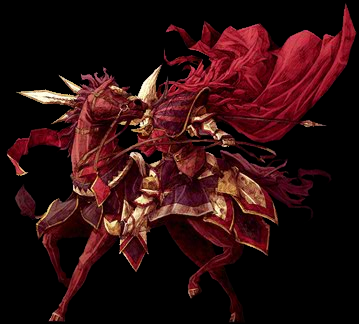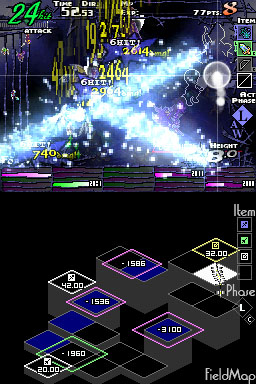 |
 |
 |  |  |  | | This is the first jRPG I’ve ever played that has entertained the notion that European Knights might have fought on horseback. |  |
I don't know if it's a comment on the lack of imagination of videogame developers these last few years, or a comment on the laziness of paid video game reviewers, but Knights in the Nightmare has the professional reviewers baffled. It’s one of the most original games on the DS and fails to fit neatly into a genre slot so the professional reviewers are hedging their bets with 7/10 scores and describing it as "one of the most complex SRPGs of all time."
Knights in the Nightmare is most certainly not the most complex SRPG of all time. To be fair, the game itself shares some of the blame for this misconception because it has the worst tutorial since the original Final Fantasy Tactics, with over 100 topics spread across 3 different tutorial sections, each only a sentence or two describing a single game mechanic in limbo. It's so confusing, Atlus released a 4-part supplemental tutorial on Youtube. The big secret to understanding this game is that while it does have aspects of SRPGs and shmups, like the box says, there is a third unlikely genre that casts a much longer shadow over the game: Football Management.
Knights in the Nightmare is currently my favorite game on the DS. The premise is that erstaz-King-Arthur was murdered, a portal to hell was opened in his castle, and demons are running amok through the countryside, killing knights and commoner alike. You play the disembodied ghost of erstaz-Arthur, gathering an army of dead knights and fighting his way back to the castle. Kind of like what Hamlet would have been if the ghost of Hamlet’s father went back to his ghost posse after delivering his monologue and said, “Meh, my son’s such a whiny emo putz he’d probably get himself and half his friends killed before avenging my death. Assemble the crew, we’re going this alone.” Then one of the ghosts replies, “Word,” and another, “Verily, shit just got real.”
 |  |  |  | | If you were to take the the basic SRPG formula of TANK TANK TANK, SNIPE SNIPE SNIPE, HEAL HEAL HEAL, NUKE NUKE NUKE and simplify it down to the bare essentials, wouldn’t you make a game that’s just NUKE NUKE NUKE? |  |
The game proceeds in a series of battles like a season of football with story segments bookending each game. Between games you do the equivalent of training and trading players (distribute exp, fuse souls) and maintaining equipment (fusing and powering up weapons). You have a specific number of turns to win each battle, like downs in football. Before each turn, you see the playfield and the enemy placement, pick your players, and plan your tactics. But actually pulling off the tactics successfully requires you to succeed in a reflex-based action segment.
The sports game analogy is especially apt when it comes to the un-RPG-like rules. Each battle is between your knights and a team of 9 to 25 monsters. The lifebars for all the monsters are arranged in a matrix at the bottom of the screen, but you only fight a random selection of 3-5 monsters per turn. Winning the match requires killing enough monsters to make a vertical, horizontal, or diagonal line of dead monster lifebars across the matrix, which in story terms is cutting a hole big enough in the enemy ranks to break through.
In the action segments, your ghost is represented by a floating hitbox called "the Wisp" and controlled by the stylus. Enemy monsters can detect you, but the only way they can hurt you is by shooting magic bullets at you. You can't hurt monsters directly, but thanks to their bloodthirsty rampage, there are ghosts of recently killed knights all over the place. Grabbing a weapon and dragging it over to a Knight's silhouette gives them their bodies back temporarily and charges up an area attack at the cost of time and MP. Instead of a lifebar, you have a static timer that is decreased when charging up knight attacks, or getting hit by an enemy bullet. A turn ends when the timer runs out, or all the monsters onscreen are killed.
The paid, professional reviewers like to describe the shmup action as “bullet hell” because that’s the only word for shmups they know. The number of actual bullets on screen don’t come close to bullet hell standards. Most enemy projectiles are large thematic sprites that move in unusual patterns. It’s when you have 5 enemies onscreen, all shooting at you at once, that things get truly hectic. The closest equivalent to this game in terms of shmup gameplay is the mouse-controlled freeware La Soeur Barrage. One thing that’s cute is that passing dangerously close to a bullet grants bonus experience, making RPG experience-grinding and shmup bullet-grinding into the same activity.
There's more to a match than just killing the monsters - there are objects scattered all over the stage like candlesticks and rocks that, Castlevania-style, contain weapons and "Key Items" (mementos of a dead knight's life, like a wedding ring or a bottle of booze). Knights will only join you permanently if you have their key item and drag it to them. Since you are limited to 4 items of any type per turn, you might "punt" one turn by just stocking key items and no weapons, then converting the unused time into MP. Also, later in the game the knights on the battlefield start in bad locations and only 2 types of knights can actually move. So you might spend one turn with a duelist knight doing nothing more than jumping up to a high platform, and the next turn replacing that duelist with a now-ideally-situated archer.
Even the character development has more in common with football games than SRPGs. In an RPG, overusing a single character will result in that character becoming stronger and deadlier than the rest of the party. Here, all your knights have a limited amount of vitality that permanently drains with every attack they make, the stronger the attack, the more vitality lost. Experience gained is put in a pool that you distribute between matches. Relying excessively on one super-fighter will quickly wear that knight out, or could even permanently kill him. If you do want a super-knight, you can bench a promising rookie for several battles and pump all your experience into him until he's strong enough to use a high-level weapon you've been saving, then bring him out to wreak some havok in a boss fight.
The art design is beautiful. The whole game takes place at night, but instead of a greyed out color palette, the lit spots on the screen are awash with bright saturated primary colors. Weapon effects are flashy and impressive, but don't overstay their welcome like in Final Fantasy games. Special mention must be given to the ridiculously ornate armor every single knight in the game wears. It's like the Society for Creative Anachronism visiting Rio for Carnival. My personal favorite is one chick who just wears a blue bikini with enormous shoulder plates that go above her ears, arm plates, and gauntlets that scrape the ground. No doubt Yahtzee would go into a tizzy after seeing that these knights showed up to the Apocalypse wearing that!
The plot is told, Memento-style, in flash forwards and flashbacks. Maybe the non-chronological storytelling is a cheap trick, but it does make the plot more interesting than the last few JRPGs I've played. I'm a few bosses into the game so far and the story has already taken a couple truly dark turns. I'm cautiously optimistic that it won't pull a "Disgaea" and suddenly drop its dark premise to start preaching to me about the importance of love.
It's weird, it's dark, it's beautiful, it's one of the most original games in the DS library. No doubt this will be high on future lists of underappreciated gems. Highly recommended!
 Mischief Maker Mischief Maker
|  |
|
|

